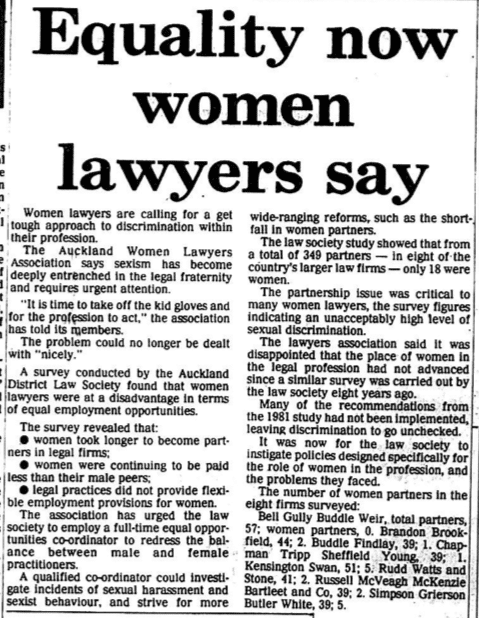President: Pip Muir

In 1981, a Working Party was set up to examine the position of women in the legal profession. From 1981 to 1989 there were significant changes in both the number of women entering the profession and the way women practitioners were involved in the profession. In 1989, a second Working Party was set up to review the original 1981 report and produce a further report for the ADLS.
The report produced by the 1989 Working Party was an extremely worthwhile document which was of great interest and educational value to the profession. The report contained several important recommendations for the ADLS to consider and potentially implement, for the benefit of the profession and the public.
The 1981 report and recommendations were reviewed by the second Working Party. As part of the second Working Party’s review, a survey was commissioned by the Heylen Research Centre and sent to 900 members of the legal profession.
The report focused heavily on the results of the Heylen survey, with an aim of re-visiting the issues raised in the first Working Party’s report to assess how these issues have been considered and/or implemented by the ADLS. The Working Party called for and received oral and written submissions from many, including AWLA. AWLA made substantial submissions which were referred to throughout the report.
A key focus of the survey concerned the experiences of women in the legal profession:
- Personal career satisfaction and aspirations;
- Perceived prospects for advancement;
- Factors believed to impede personal development and advancement;
- Perceptions regarding areas of law more difficult for women than men (and vice versa);
- Perceptions regarding prejudice and discrimination against women practitioners; and
- Factors affecting child care and parental leave.
The survey revealed a number of areas disadvantaging women in terms of equal employment opportunities. While it was for the ADLS to consider the most appropriate means of addressing research findings, the second Working Party’s report discussed the key concerns and made recommendations to address issues.
The key concerns for women working in the legal profession which were highlighted in the survey and considered by the Working Party included childcare, tax deductibility (of childcare), parental leave, sickness leave, flexible employment options and partnerships. Other issues considered included the effect of mergers/amalgamations, elimination of sexist/exclusionary language from the profession, elimination of sexist behaviour, sexual harassment, academic women, corporate women and women employed by government agencies and Māori women.
The report of the second Working Party concluded with an assessment of the earlier report, noting which issues raised in 1981 had been addressed. The 1981 report made 17 recommendations to the ADLS; only five of the recommendations were implemented. It was accepted that many of the recommendations were general statements of principle requiring endorsement only rather than action. The two areas the second Working Party deemed to be of continued concern due to the disadvantage disproportionately facing women were:
- Practical responses to child care problems; and
- The need for taxation reform regarding child care.
The standing committee (CWIP) was responsible for implementing the reports recommendations which the Council resolved to establish. CWIP had a limited period of activity and ceased functioning before the 1989 review. The Working Party concluded that the obligations left to a committee of voluntary members under constant pressure of work (and having regard to the scope of the recommendations to be implemented) were unduly burdensome and that the committee’s demise was inevitable.
AWLA reported on these findings and collated their own research on the numbers of women in partnership, this was published on the front page of the New Zealand Herald on 11 September 1989. This highlighted that it took women longer to be promoted to partnership in law firms, they continued to be paid less than their male peers, and that law firms did not provide flexible employment provisions. The research showed that out of the country’s eight largest law firms, only 18 of 349 partners were women. AWLA called for the deep entrenchment of sexism and discrimination within the legal profession to be urgently addressed. AWLA critiqued the lack of progress on this issue in respect of the similar report and recommendations published by the NZLS in 1981.


